Artificial Intelligence (AI) has shifted from boardroom buzzword to boardroom mandate. Every IT leader today is under pressure to “do something with AI.” Yet, despite billions poured into experiments, a surprising number of organisations struggle to see real returns. McKinsey research shows that while more than 70% of companies are piloting AI, less than 25% consistently realize measurable ROI.
Why does this gap exist? Because most organisations don’t have a structured AI Adoption Framework. Instead, they run isolated pilots, chase hype technologies, or implement tools without a business case. For decision makers, this leads to wasted investment, lost time, and frustrated stakeholders.
The good news? With a framework, IT leaders can turn AI from an experimental playground into a measurable growth engine. Let’s break down how decision makers can use an AI adoption framework to achieve faster ROI, reduce risks, and scale confidently.
Why IT Leaders Struggle with AI Adoption
Before we talk solutions, let’s face the reality: IT executives are not short of ambition. The stumbling blocks are structural and cultural. Common pain points include:
- Unclear business objectives – AI projects launched because “competitors are doing it,” not because they solve a pain point.
- Pilots stuck in limbo – Initiatives never graduate into enterprise rollouts.
- Data chaos – Siloed, poor-quality datasets make ML models ineffective.
- Skill and culture gaps – AI is often owned by “data science teams,” leaving business leaders disengaged.
- ROI mismatch – Boards demand results in quarters; AI projects take years without a framework.
The solution: A structured AI Adoption Framework. It gives leaders a systematic path from concept to ROI, balancing speed, risk, and scalability. According to McKinsey’s State of AI report (2024), while over 70% of companies are experimenting with AI, fewer than 25% consistently capture ROI at scale (Source: McKinsey).
The Core Pillars of an AI Adoption Framework
An effective framework isn’t theoretical—it’s practical. Here are the pillars that decision makers should embed into their roadmap.
1. Define Clear Business Objectives
Pain Point: Many IT companies deploy AI for the sake of adoption, not value.
Solution: Anchor every project to measurable outcomes. Example: reduce downtime by 20%, increase client satisfaction scores by 15%, or cut support costs by 30%. By defining clear business objectives, leaders can justify investment and track ROI with confidence.
2. Data Readiness & Governance
Pain Point: Dirty, siloed data is the biggest reason AI projects fail.
Solution: Establish governance frameworks that emphasise quality over quantity. Break down silos, enforce compliance (GDPR, HIPAA, etc.), and ensure ethical use of data. Without trusted data, even the best ML models collapse.
3. Choosing the Right AI Tools
Pain Point: With thousands of platforms, CIOs face tool fatigue.
Solution: Evaluate AI tools based on compatibility with existing IT systems, scalability, and support for advanced machine learning (ML) models. Favor platforms that accelerate deployment and integrate seamlessly with enterprise workflows.
4. Build a Cross-Functional AI Team
Pain Point: AI fails when it lives only in data labs.
Solution: Create a cross-functional AI team—data scientists, IT leaders, compliance experts, and business stakeholders. This collaboration ensures AI aligns with real-world needs, not just technical ambition.
5. Pilot Projects as a Starting Point
Pain Point: Leaders often overcommit budgets to unproven initiatives.
Solution: Start with pilot projects that deliver value in 6–12 weeks. Prove ROI in one area, then scale. A successful pilot acts as both a learning curve and a credibility booster.
The ROI Equation: Turning AI into Measurable Business Value
C-level leaders care about one thing above all—returns. Yet AI ROI is often fuzzy. To make it tangible, break it into four levers:
- Cost Savings – Automating repetitive IT workflows, reducing manual errors, optimizing cloud spend.
- Revenue Growth – Using ML models to identify upsell opportunities or launch data-driven services.
- Productivity Gains – Freeing employees to focus on strategic work, not ticket management.
- Risk Reduction – Strengthening cybersecurity and ensuring compliance with AI-driven monitoring.
Pro Tip for Leaders: Tie AI ROI to existing board-level metrics. Don’t invent new measures; align AI with KPIs the business already values.
AI Adoption: Aligning Technology with Strategy
Too often, AI projects sit in silos—separate from enterprise goals. This disconnect kills momentum.
Solution for Decision Makers: Treat AI as a strategic lever, not a side project. Align it with your digital transformation roadmap, client demands, and revenue priorities. When AI sits at the core of IT strategy, not the periphery, adoption accelerates and ROI multiplies.
The Human Factor in AI Adoption
AI doesn’t fail because of algorithms; it fails because of people. Employees resist adoption when they fear “AI will take my job.”
Solution: Leaders must humanize AI. Position it as an augmentation, not replacement. Invest in reskilling programs. Communicate the “change story” clearly—AI is here to make work smarter, not redundant. McKinsey highlights that companies fostering trust and transparency in AI adoption achieve significantly higher ROI.
Risk & Compliance: Safeguarding AI Investments
For CIOs and CTOs, AI brings a new dimension of risk:
- Algorithmic bias
- Data privacy violations
- Regulatory non-compliance
- Intellectual property risks
Solution: Integrate risk and compliance into your AI adoption framework. Build governance protocols from day one. Assign accountability—make compliance a leadership agenda, not an afterthought. This transforms AI from a potential liability into a safe growth driver.
From Pilot to Scale: Unlocking Faster ROI
How do you move from proof of concept to enterprise-wide adoption? Leaders need to:
- Replicate success – Scale what works across functions.
- Standardize processes – Create reusable templates for model development and monitoring.
- Embed feedback loops – Continuously improve based on real-world performance.
- Track ROI rigorously – Use dashboards that connect model outputs with business KPIs.
Scaling is not about speed alone—it’s about disciplined, measured growth that delivers ROI at every stage.
Industry Benchmarking: What Leaders Are Doing
Decision makers often ask, “Where are my peers investing?”
- Financial Services: AI for fraud detection and risk scoring—direct ROI in reduced losses.
- Healthcare: ML models improving diagnostics and patient throughput.
- IT Services: Predictive maintenance reducing system downtime.
- Public Sector: AI-driven citizen services improving efficiency and trust.
SADA highlights that across industries, the biggest gains come not from one-off experiments but from structured frameworks that tie AI to outcomes. As SADA highlights in its analysis of real-world AI use cases, the biggest gains come not from one-off experiments but from structured frameworks that tie AI to outcomes (Source: SADA).
Building an AI Center of Excellence (CoE)
Scaling AI without structure leads to duplication and wasted budgets. That’s why industry leaders are creating AI Centers of Excellence.
Three steps for decision makers:
- Define mandate – Align CoE with business strategy.
- Build the team – Blend data, IT, compliance, and business experts.
- Roll out playbooks – Standardize practices for pilots, scaling, and governance.
A CoE acts as the “AI compass” for an organization—ensuring consistency, efficiency, and ROI across departments.
Common Pitfalls in AI Adoption
Even with frameworks, leaders fall into traps:
- Over-engineering models that don’t solve business problems.
- Ignoring employee adoption and change management.
- Chasing hype (e.g., generative AI) without considering value alignment.
- Neglecting governance and integration risks.
The message is clear: Don’t chase technology for technology’s sake. Lead with strategy, anchor on people, and manage risks.
Real-World Use Cases That Deliver ROI
- IT Operations: ML-powered predictive analytics cut downtime by 40%.
- Customer Service: Chatbots + human-in-the-loop improve response times while cutting costs.
- Cybersecurity: AI anomaly detection reduces breach risks by 30–50%.
- Workflow Automation: Process automation saves thousands of hours annually, yielding faster ROI.
These examples prove that when AI adoption is structured, ROI is not aspirational—it’s measurable.
Best Practices for Decision Makers
- Make AI part of the boardroom agenda.
- Start small, prove value, then scale.
- Build an AI CoE for consistency.
- Measure ROI using existing business KPIs.
- Partner with experts (like Kansoft) to accelerate without overextending internal teams.
The Road Ahead: Emerging Trends Leaders Should Track
To future-proof investments, CIOs should watch:
- Generative AI in IT Ops – speeding incident resolution.
- AI for cybersecurity – real-time anomaly detection.
- No-code/low-code AI – democratizing adoption across business teams.
- Cloud cost optimization with AI – a top priority in 2025.
Leaders who stay ahead of these trends will not only adopt AI—they’ll lead with it.
Conclusion
AI can be your company’s most powerful accelerator—or its most expensive experiment. The difference lies in having a framework.
For IT decision makers, the call is clear:
- Define clear business objectives.
- Empower cross-functional teams.
- Start with pilots, scale responsibly.
- Safeguard investments with governance.
- Build trust with people, not just algorithms.
This isn’t just about technology. It’s about leadership, clarity, and impact. With the right AI Adoption Framework, IT leaders can deliver faster ROI, long-term resilience, and market leadership.



